



Feature Story
More feature stories by year:
2024
2023
2022
2021
2020
2019
2018
2017
2016
2015
2014
2013
2012
2011
2010
2009
2008
2007
2006
2005
2004
2003
2002
2001
2000
1999
1998
 Return to: 2016 Feature Stories
Return to: 2016 Feature Stories
CLIENT: LA CONSULTING
Dec. 2, 2016: Public Works
One management concept. Two public works departments. Don't reinvent the wheel when you can use their proven technique for culture change.

From left, consultant Harry Lorick, PE; Orange County Public Works Assistant Director/County Engineer Khalid Bazmi, PE; and Mesa Water District Assistant General Manager Phil Lauri, PE., at the Mesa Water Reliability Facility in Costa Mesa, Calif.
Public works managers often strive to improve their performance and optimize resources. One way to do this is to go through the process of becoming a high-performance organization (HPO).
The concept was developed by the U.S. Office of Personnel Management in the 1990s. An improvement on the framework for the application of that concept was developed by the HPO Center in The Netherlands. Statistical analysis of data collected from 1,470 public- and private-sector organizations in 50 countries revealed 35 characteristics that correlate to competitive excellence. Released in 2008, the HPO Framework breaks these characteristics into five categories:
Becoming an HPO is different than gaining accreditation by the American Public Works Association (APWA). APWA forces agencies to establish processes, documentation, plans, and management methods to meet specific, defined association practices. The process doesn't require them to demonstrate accomplishments, cost savings, or efficiency gains.
The high performance organization (HPO) philosophy is a reiterative process that emphasizes continuous results evaluation and benchmarking against an organization's peer group.
Initial steps include identifying current and future functions and financial need, reviewing management policies, and defining the desired organizational culture. From there, an agency can begin to put in place a new vision and set of values that reflect HPO-specific culture and goals.
The next step is implementing a revised strategy and structure.
Public agencies can expect improvements in daily and long-term customer service, employee productivity, and financial performance.

Becoming an HPO does. After defining critical performance indicators for their operation, designees collect work, cost, and response data to help prove they are effectively investing public monies. This data is compared to comparable peer agencies as a benchmark. Employees help the agency exceed these relala-12tive benchmarks for at least five consecutive years to be deemed an HPO. This can be achieved by "focusing in a disciplined way on what really matters to the organization."
Like any operational tool, one size does not fit all. Agency size, management structure, technology, resources, and processes impact how the framework is implemented. As a manager, you must design a variant that fits your agency's needs and goals.
This article explains the philosophy using two public agencies in California: one operating as an HPO and another striving to become one. The concepts we outline can be applied to any public works organization.
Many government agencies have "top-down" control structures. These bureaucratic hierarchies often produce inefficient and repetitive communication chains. Job roles are specialized and narrowly defined.
All these factors can lead to a rigid framework incapable of adaptation.
In contrast, an HPO consists of autonomous and self-regulating work units. Employees communicate directly with decision makers and information is transparent and easily accessible.
"The HPO Framework is a scientifically validated process for deciding what to focus on to improve and sustain organizational performance."
One key tool an HPO has at its disposal is documentation. An agencywide understanding of core processes and procedures facilitates informed and proactive decision making at all employee levels.
HPOs more accurately gauge successes and failures because they collect highly detailed performance data. Insights derived from that data reach all employee levels faster because bloated communication channels no longer exist. As a result, the organization identifies and solves problems more quickly and efficiently. They save money, work more efficiently, employ happier people, and have happier customers.
As a rule, no agency should expect to make a transition without some adversity, and the Orange County Public Works Department and Mesa Water District are no exception. Each faced hurdles. As with many large-scale implementations, the cost versus benefit was at times challenged by various stakeholders.
When this happened, strong commitment from the agencies' top leaders advanced the realization of lasting change. As a result, the agencies are far better prepared to withstand shifts in organizational structure, updates in technology and processes, and other unforeseen challenges.
Services: Facility, street, bridge, and fleet design, construction, and/or maintenance; permitting and inspections; parking administration; surveying; flood control, watershed management, and water quality; pesticide regulation; traffic engineering; vegetation management
Service area: 790 square miles
Assets: 319 road miles, four dams, seven pump stations, 350 flood channel miles, nine million square feet of buildings as well as four contract cities
Population: 3.1 million
No. employees: 920
Budget: $514,340,379
Mission: Protect and enrich the community through efficient delivery and maintenance of public works infrastructure, planning, and development services.
Since beginning the HPO journey in 2014, the Orange County Public Works (OC Public Works) in Santa Ana, Calif., has saved $7 million for the department and another $1.6 million elsewhere within the county.
Before then, this enormous agency struggled with issues common to public works departments of all sizes and varieties.
One-to-one communication frustrated employees and created a culture of disconnection. The process for documenting and updating basic procedures wasn't easily accessible between divisions and work units couldn't access key information. Often, this hindered the agency's ability to respond to unexpected high-priority work orders and customer complaints.
Managers and governing bodies can anticipate continuous improvement for years to come when a public works agency decides to undergo the high-performance organization (HPO) process. California's Orange County Public Works Department (OC Public Works) hopes to achieve the designation by 2020, but is already running more efficiently by replacing a conventional organizational structure with a wider span of control.
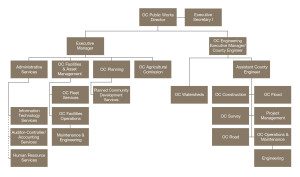
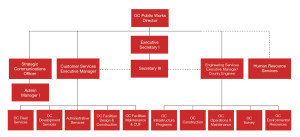
To better serve customers and employees, the agency committed itself to establishing a culture that values leadership and strong direction. Priorities include improving resource allocation, task automation, and asset identification. Its vision is to provide excellent, innovative, and professional projects and services.
Over the last two years, the agency assumed new leadership, replaced a conventional organizational structure with one that widens span of control, and began a continuing process of technology upgrades.
By streamlining hierarchies, the first two changes simplify communication and minimize redundancy. Rather than linear reporting relationships, employees can view at any time, through internally developed systems, a snapshot of scheduled tasks, assets and goals, and reported issues across the department's 10 divisions. They've also received training to expand skill sets so they can more easily fill in elsewhere as needed, improving overall service delivery.
Over the last six months, the agency has:
In addition, managers in each division also host monthly coffee meetings. Each change makes it easier for employees to contribute to achieving the agency's overarching mission to operate more efficiently and provide better service. Going forward, the department plans to create partnerships with employees and implement a bottom-up management style.
Continued success via process refinement also depends on internal and external benchmarking. Comparing agency metrics to other government HPOs gives managers and employees a sense of how far they've come and what they have yet to achieve.
To that end, the agency is in the early stages of establishing key metrics. Its goal is to become an HPO by 2020.
While OC Public Works toward becoming an HPO, another California public works agency is operating as one: Mesa Water District.
Services: Potable water treatment and distribution
Service area: 18 square miles (Costa Mesa, parts of Newport Beach, and some unincorporated sections of Orange County, including the John Wayne Airport)
Assets: 23,786 water meters; 350 miles distribution line; two reservoirs; seven active well sites; 8.6 mgd treatment plant
Population: 110,000
No. employees: 57
Total budget: $24,522,420
Capital improvements budget: $8,400,000
Mission: Dedicated to satisfying our community's water needs.
The Mesa Water District in Costa Mesa, Calif., became an HPO in 2015. In the process, the urban/suburban utility achieved:
"The HPO Framework cultivates a culture that retains employees with prized technical skills."
Relationships with customers have also improved. A study of 509 customers found 95% statistical confidence (+/- 4.3%) in the following areas:
Finally, using information that the state Department of Water Resources requires utilities to submit to state and regional control boards, the utility achieved lower rates and per-capita expenditures than other benchmark agencies in Orange County.
California's Department of Water Resources requires utilities to regularly submit operational and testing data to state and regional control boards. The Mesa Water District in Costa Mesa retained a consultant to compile information provided by other Orange County water providers. The analysis showed the utility outperforming peers on at least two of seven benchmarks: rates and per-capita expenditures.
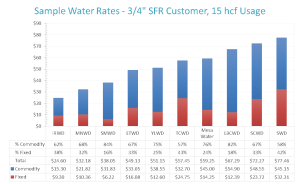
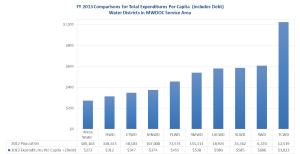
Mesa Water District began its journey by defining seven benchmarks that reflect its values and ensure high performance internally and externally. Although the utility isn't APWA-accredited, one goal was implementing the association's four management principles of planning, organizing, directing, and controlling.
The utility also uses the principle of Pareto's law: Significant goals represent 20% of work but account for 80% of a department's output.
All data that affects performance is documented, easy to access, and understand. Team members are able to view financial and management reports. Managers frequently engage in dialogue with employees. An annual financial and safety audit tracks progress and identifies areas for improvement.
The key to continuing improvement was and continues to be an automated management approach via a new computer maintenance management system (CMMS). MaintStar Inc. is used throughout the district to document work performed, including labor and equipment rates, by all functions. Presented in easy-to-grasp visuals, this information is used to establish and monitor guidelines.
The 2011 edition of the American Public Works Association's Public Works Management Practices Manual presents four principles for managing maintenance. One of the Mesa Water District's seven high-performance organization (HPO) benchmarks was to implement these principles.
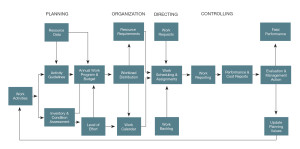
Managers use the software to monthly project needs and determine workload. Analyzing a year or more of data gives them a comprehensive overview of work group and asset capability they use to develop annual and long-term plans that target resources most effectively.
Work requests, scheduling, and assignments are submitted and processed through a fluid communication plan. Finally, performance and cost reports along with other benchmark information can be viewed in real time, allowing for proactive planning and adaptation.
In pursuit of HPO designation, OC Public Works continues to tweak operations internally and externally. Since achieving HPO status, Mesa Water District continues to provide water more effectively and abundantly than water districts in the region. Both agencies have greatly improved business systems, processes, and methods by more effectively deploying best management practices.
If you or your team aren't sure whether to initiate an HPO transition, rest assured that the benefits can be seen almost immediately. The process uncovers value and sources of untapped potential from the outset.
Initial steps, such as performance documentation, reveal strengths and weaknesses you can use to establish benchmarks with which to identify improvement opportunities. Obvious commitment from upper management will ensure all-employee participation by setting the tone for the process.
Because they're engaged from day one, employee attitudes shift. They see how their involvement impacts the process and become invested in its success. Expect continuous improvement for years to come.
Return to: 2016 Feature Stories